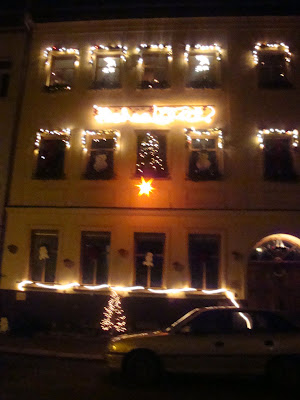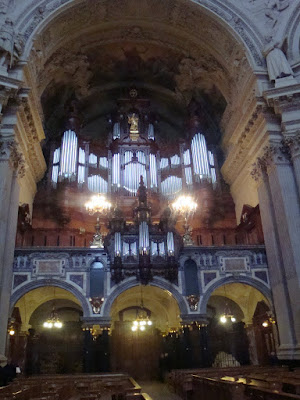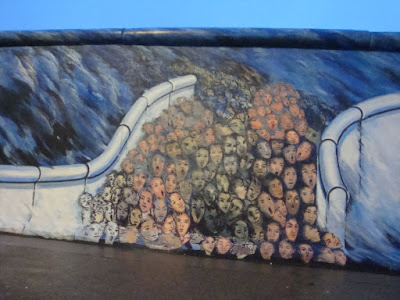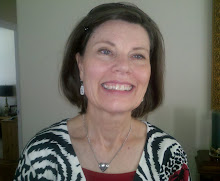Our good friends, the Krauses from Gera, invited us to tour Berlin. We took the train to Gera on Friday evening where they met us and took us to their home by way of the Christmas Market.
GERA
 This is the front of their home. It is unusual because most people do not decorate the outside in the cities. It is really an apartment complex. They live on the top two floors and work in the other areas. Eventually there will be apartments to rent out on each floor.
This is the front of their home. It is unusual because most people do not decorate the outside in the cities. It is really an apartment complex. They live on the top two floors and work in the other areas. Eventually there will be apartments to rent out on each floor.  This is the living area. They had more fun things to look at and many lit candles around to provide light.
This is the living area. They had more fun things to look at and many lit candles around to provide light.BERLIN
We got up at 5:00 A.M.on Saturday to begin our adventure to the Big City. We spent the better part of 8 hours walking in the cold....but well worth it all.
 We arrived just as the sun was coming up at the Reichstag Building. It housed the first parliament of the German Empire in 1894. It was partly damaged by fire in 1933, refurbished in the 60s and fully restored in 1990. It is now the meeting place for the modern German parliament, the Bundestag. Notice the dome on the back part of it.
We arrived just as the sun was coming up at the Reichstag Building. It housed the first parliament of the German Empire in 1894. It was partly damaged by fire in 1933, refurbished in the 60s and fully restored in 1990. It is now the meeting place for the modern German parliament, the Bundestag. Notice the dome on the back part of it. In 1916 the words "Dem Deutschen Volke" (To the German People) were carved above the main facade of the building much to the displeasure of Wilhelm ll.
In 1916 the words "Dem Deutschen Volke" (To the German People) were carved above the main facade of the building much to the displeasure of Wilhelm ll. We are in the top of the dome. It catches the sunshine and gives light to the main area where the Parliament meets. There is a shade they use to brighten or dim the lighting that rotates around it.
We are in the top of the dome. It catches the sunshine and gives light to the main area where the Parliament meets. There is a shade they use to brighten or dim the lighting that rotates around it. The mirrors to catch the sun...looking down from the top. You can almost see the big Parliament room through the glass on the bottom. There were pictures around it of the history.
The mirrors to catch the sun...looking down from the top. You can almost see the big Parliament room through the glass on the bottom. There were pictures around it of the history.  The Brandenburg Gate is one the main symbols of Berlin and Germany and is considered one of Europe's most famous landmarks. It is one of the only remaining gates which one formerly entered Berlin. It led directly to the city palace of the Prussian monarchs. It was just barely inside East Berlin when the wall went up.
The Brandenburg Gate is one the main symbols of Berlin and Germany and is considered one of Europe's most famous landmarks. It is one of the only remaining gates which one formerly entered Berlin. It led directly to the city palace of the Prussian monarchs. It was just barely inside East Berlin when the wall went up. This tree was brought into the city for Christmas and is inside the Gate.
This tree was brought into the city for Christmas and is inside the Gate. The Berliner Dom (Berlin Cathedral), the parish church of the Evangelical congregation
The Berliner Dom (Berlin Cathedral), the parish church of the Evangelical congregationThis is probably the most common religion in Germany.
 First part was built in 1451, second part in 1750, third part in 1905 and repaired in 1993 from the effects of WWll.
First part was built in 1451, second part in 1750, third part in 1905 and repaired in 1993 from the effects of WWll.
 This pipe organ, built by Wilhelm Suer, was fully restored during reconstruction beginning in 1975. It has 113 stops including three ranks of 32' pipes (7,369) on the pedal devision, played by a 4-manual console. (This for you Mike)
This pipe organ, built by Wilhelm Suer, was fully restored during reconstruction beginning in 1975. It has 113 stops including three ranks of 32' pipes (7,369) on the pedal devision, played by a 4-manual console. (This for you Mike) Underneath the church floor are the tombs of many of the great kings and their families.
Underneath the church floor are the tombs of many of the great kings and their families. Yes, they are in these caskets. We saw many different and ornate ones. dating back from the 1400s. Several were babies.
Yes, they are in these caskets. We saw many different and ornate ones. dating back from the 1400s. Several were babies. This bear is the symbol of Berlin. We found many of them painted in various designs and colors.
This bear is the symbol of Berlin. We found many of them painted in various designs and colors.  The Nikolaikirche is the oldest church in Berlin first built in 1220. It was originally a Roman Catholic Church, but became a Lutheran church after the Protestant Reformation in the 1700s. What you see is a reconstruction since it was reduced to a burnt out shell by Allied bombing during WWll.
The Nikolaikirche is the oldest church in Berlin first built in 1220. It was originally a Roman Catholic Church, but became a Lutheran church after the Protestant Reformation in the 1700s. What you see is a reconstruction since it was reduced to a burnt out shell by Allied bombing during WWll.TheWeihnachtmarkt is in the front and you see the Fernschturm in the back. It was built between 1965 and 1969 by the former GDR administration in East Berlin. It is the 4th tallest freestanding structure in all Europe. It is a TV tower and has a visitor platform and a rotating restaurant in the middle of the sphere.
 It is nice to see the real meaning of Christmas represented in the Christmas Markets.
It is nice to see the real meaning of Christmas represented in the Christmas Markets. The Memorial To The Murdered Jews of Europe
 This was the most emotional and intense experience of our whole tour (as you can tell by the expression on Sister Gill's face).
This was the most emotional and intense experience of our whole tour (as you can tell by the expression on Sister Gill's face).
 This is a very sacred place and you can feel those who died during this terrible time are grateful they have not been forgotten.
This is a very sacred place and you can feel those who died during this terrible time are grateful they have not been forgotten.  Underneath the 2,711 concrete stelae is an Information Center. This picture depicts a very small part of the series of texts and pictures that show the development that led to the Holocaust and the process of the extermination of the European Jewry. Each room tells the story from a different view. In the Room of Dimensions, fifteen personal accounts are written down by Jewish men and women. The Room of Families has photographs and personal documents that report on the dissolution, expulsion and extermination of these families and their members. The Room of Names is the third room and names and short biographies of Jews who were murdered or presumed dead are read out while their name, year of birth and year of death are displayed on all four walls. Reading all the names would take six years, seven months and 27 days. There is a Room of Sites where 220 sites are presented to show the different sites of mass executions, extermination and concentration camps, ghettos, deportation routes and death marches. There is another room where visitors can research the more than three million entries in a database for victims' names. It was not easy to walk through this Memorial but it is important to remember the past and as we read, when we walked in, the sign below.
Underneath the 2,711 concrete stelae is an Information Center. This picture depicts a very small part of the series of texts and pictures that show the development that led to the Holocaust and the process of the extermination of the European Jewry. Each room tells the story from a different view. In the Room of Dimensions, fifteen personal accounts are written down by Jewish men and women. The Room of Families has photographs and personal documents that report on the dissolution, expulsion and extermination of these families and their members. The Room of Names is the third room and names and short biographies of Jews who were murdered or presumed dead are read out while their name, year of birth and year of death are displayed on all four walls. Reading all the names would take six years, seven months and 27 days. There is a Room of Sites where 220 sites are presented to show the different sites of mass executions, extermination and concentration camps, ghettos, deportation routes and death marches. There is another room where visitors can research the more than three million entries in a database for victims' names. It was not easy to walk through this Memorial but it is important to remember the past and as we read, when we walked in, the sign below.
Berlin Hauptbahnhof
 Berlin Hauptbahnhof is the main railway staion in Berlin and the largest crossing station in Europe. It is Europe's largest two-level railway station. It began full operation May 2006.
Berlin Hauptbahnhof is the main railway staion in Berlin and the largest crossing station in Europe. It is Europe's largest two-level railway station. It began full operation May 2006.  The two middle floors are an upscale Mall with wonderful shopping and eating.
The two middle floors are an upscale Mall with wonderful shopping and eating.  The upper level has six tracks going East and West and eight on the lower level going North and South.
The upper level has six tracks going East and West and eight on the lower level going North and South. 1,800 trains call at the station per day and the daily number of passengers is estimated to be at 350,000.
1,800 trains call at the station per day and the daily number of passengers is estimated to be at 350,000. Checkpoint Charlie
 Checkpoint Charlie was the name given to the most well know Berlin Wall crossing point between East Germany and West Germany during the Cold War.
Checkpoint Charlie was the name given to the most well know Berlin Wall crossing point between East Germany and West Germany during the Cold War.  Checkpoint Charlie became a symbol of the Cold War, representing the separation of east and west, and ---for some East Germans---a gateway to freedom.
Checkpoint Charlie became a symbol of the Cold War, representing the separation of east and west, and ---for some East Germans---a gateway to freedom. 
Berlin Wall
 Little of the Berlin Wall is left at its original site, which was destroyed almost everywhere. Three long sections are still standing,
Little of the Berlin Wall is left at its original site, which was destroyed almost everywhere. Three long sections are still standing, A section of the eastern most wall along the Spree River is nicknamed East Side Gallery.
A section of the eastern most wall along the Spree River is nicknamed East Side Gallery. Artists from around the world have painted graffiti on these walls.
Artists from around the world have painted graffiti on these walls.

Christmas Lights as We Leave Berlin



















4 comments:
That was a spectacular tour of the city!
When I was there in Winter 1991-92 Berlin was a very different place. The U-bahn was terrible. Bare light bulbs swung from the ceiling to light the dirty stations. The trains had not been updated since before the Soviet lockdown of the 1960s. The buildings still were pocked with bullet holes - vestiges of the street fighting of World War II.
What a change freedom and capitalism can make in a country.
Thank you for that experience.
I love you!
John
This really makes me want to go to Berlin! What an amazing city.
What a great post! Loved the parliment dome and the info. on the concentration camps...so lucky you get to see all of that.
What a beautiful city at Christmas!
Interesting tidbit - across the street from the Berliner Dom was the old communist parliment building. When I was there ('96) it was abandoned and they were trying to figure out what to do with it - it was full of asbestos.
Post a Comment